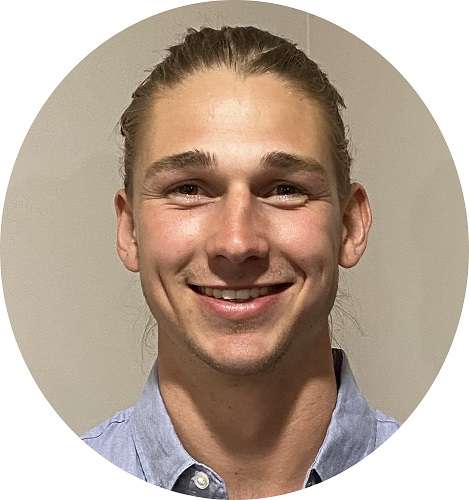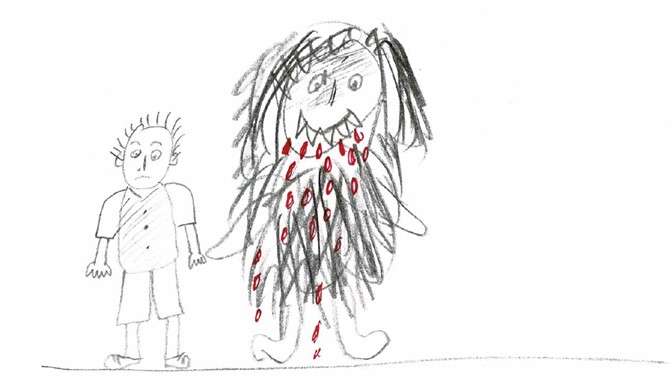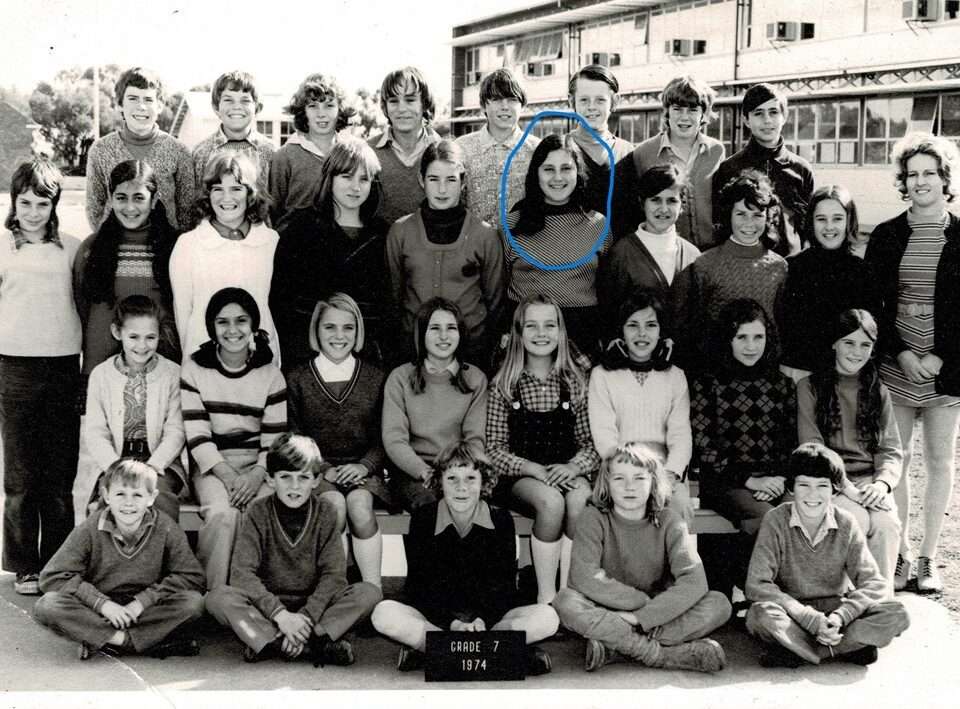
Never Changing Your Mind Isn’t A Positive Trait
03/04/2022
Creative Therapy for Anxiety
07/06/2022One of my most interesting experiences with persistent pain happened approximately 25 years ago. It was in the early days of my practice and trying to help people look at pain differently. While this was specifically about headaches/migraines, it could have been about pain in any body part – I would have followed the same therapy pathway back then.
A mother brought her eight-year-old son, Peter (not his real name), in to see me. He had been having severe headaches and migraines for the last four years. A week did not go by without a migraine or headache and at times he had 3 to 4 and a week.
Peter had been taken to nearly every specialist in Adelaide and nothing could be found. He had been given medication, and a multitude of scans, had diet changed multiple times etc. Peter and his mother were exhausted. They reported that the GP had suggested they see me. I jokingly said, “good to see I’ve gotten in before the chicken sacrifice” and his mother responded, “we were almost tempted to do that” and she wasn’t joking! They were desperate.
Peter’s mother and the many medical specialists he had seen could not pinpoint how or why these migraines had started but given the amount of testing he had had it was safe to say that there was no pathology that we needed to worry about.
I asked the most important question, “what was happening four years ago?”
Peter’s mother thought long and hard and she couldn’t really pinpoint anything because her head she was running through what could have had happened to cause these migraines.
I asked her to leave the migraines to one side and just tell me if there had been any major changes 4 years ago. Her face changed and she said, “Peter’s dad and I separated.”
She hastened to add, “it was very amicable and we get on very well – we never used to fight. It’s just that our relationship became one of friendship. We both have new partners and we’ll catch up together every now and then. There have been no problems in parenting Peter and we share him 50-50.”
Now you may think that this is a dream separation. Both adults have sat down amicably and decided to separate in a civil way, to continue parenting in a cohesive way, and to remain friends. These are the couples psychologist never see.
But for a four-year-old, who is single child, this would be perceived quite differently. Here he was, going along quite happily with two calm parents, with no fighting, and suddenly his world is turned upside down with a separation. He now has not one but two homes and is ferried between them weekly. It doesn’t matter that his parents are civil and even friendly – in fact, it makes it worse. I suspect that Peter would have understood the separation if his parents were having regular screaming fights. But a separation when everything seemingly was going well to a four-year-old is destabilising. Hence the start of the headaches and migraines.
I discussed this with mum and she was amazed that this could have been the cause because it was so simple. I repeated a saying that I have used time and time again over the last 25 years – “when you hear the sound of hooves, it’s generally horses not zebras.” All the tests Peter had had were looking for zebras.
She agreed to allow me to follow my hypothesis as “nothing else had worked” but she informed me that they had spent a lot of money on past assessments and interventions and had very little for psychological therapy.
I was fascinated with this case and decided to implement therapy by correspondence.
I believed that Peter’s headaches and migraines had started after the separation. This was his way of withdrawing into himself and using a somatic expression for his distress which was difficult to speak about as a four-year-old. After a while his brain turned his migraines into a habit. Having migraines was now normal and being migraine free was abnormal.
This all happened at a time when I was starting to understand the importance of the brain in developing pain states. Neuroscience was starting to poke its head up and there were some quite brave individuals in Adelaide who took the flag and ran with it.
Peter was a very bright eight-year-old and these were the days before email. Peter and I agreed that we would write to each other and start a story that we would each add to. I asked Peter if he could be the illustrator and he agreed.
I remember starting the story quite simply and sending it to Peter to continue the story.
“there was a lovely boy named Peter and he had a migraine called ……”
Peter returned the story to me within a couple of days. These were the days where it was exciting to get a letter 😊
Peter had written
“…. Migi. Migi was big and scary with big teeth. Peter was frightened of Migi. Peter did everything Migi wanted.”
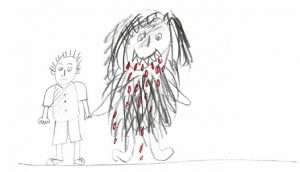
Peter and Migi the Migraine
He had drawn a picture of himself and Migi and it was quite disturbing, but a good indication of the power imbalance between him and his pain.
We had a few letters back and forth with the ongoing story. It started to look promising as a dynamic was changing and then one day Peter wrote
“Migi had been naughty and Peter was tired of him. He decided to lock up the fridge and Migi started getting skinnier and skinnier. He asked Peter for help but Peter didn’t want to help him because of everything he had done to him.”

I was so excited when I got this story continuation. I thought to myself “this is great – we going to kill Migi off” and so my next story continuation was geared towards this. The demise of Migi! I was excited! I kept checking my mail daily but Peter delayed the final letter by couple of weeks.
When I eventually opened it, the ending of the story very different to what I had expected.
This is what Peter wrote:
“Migi was becoming very sick and about to die, but Peter felt sorry for Migi and decided to help him. He told Migi that he would give him a chance to behave but if he didn’t he would be in trouble.”
And the illustration was spectacular. Peter was able to choose how and when to end this therapy.
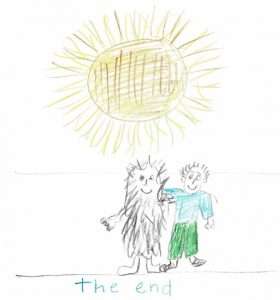
I was stunned and realised that I had nearly made a horrific mistake in therapy. I was leading Peter down a path that I thought was useful. But let’s face it, even if my hypothesis was correct, was there any chance someone who had had migraines a few times a week for four years would never have another migraine. Which is what would have had to happen if we had killed Migi off. The moment Peter had a migraine, his first thought would have been “Migi is powerful – there is nothing I can do”. I would have contributed to his sense of powerlessness.
I rang Peter and mum approx. four weeks later asking if they wanted to come into my office and we would go for a gelato, asking if Peter and Migi were allowed to eat gelato. Peter proudly told me that he could now eat anything he wanted and it did not affect him.
We caught up and Peter was a very different child as was his mother. She was thrilled with the transformation and reported that Peter had only had two migraines in the last four weeks. Peter agreed with this and reported that “Migi had been naughty” but that he had warned him and he was now behaving.
This was a spectacular lesson for me that pain is complex.
Whilst Peter and his mother was thrilled with the outcome, I felt that I had gained more from this interaction.
I will be eternally grateful to Peter and Migi. I have looked outside the box when treating all pain conditions and been the Artist as well as the Scientist in my interventions.
Out of Migi the Migraine has come our group Pain Programs for adults for the last 25 years and now for children as young as 10. Please get in touch today on our Enquiry page or send us an email ua.moc.tcennochcyspnogarap@nimda.








